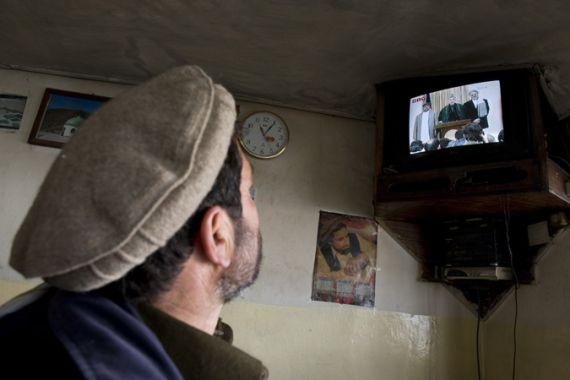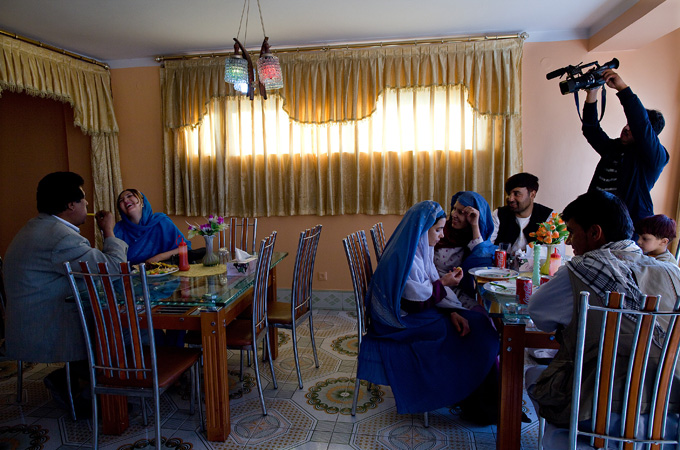Tuning in to Afghan national unity
Can political and social satire on TV bring Afghanistan’s fractured society together?

 |
| New TV programmes are helping to reconnect Afghans in a country fragmented by protracted wars and rudimentary communications and transport infrastructure [GALLO/GETTY] |
Afghanistan’s National Directorate of Security (NDS) has reportedly identified at least half a dozen small newspapers and TV stations that are funded by either Pakistan or Iran. This hardly came as a revelation to most urbane Afghans whose diet of news and information during the past ten years has often been peppered with what has been described as foreign political and cultural propaganda. In the run-up to the US military drawdown, and with the potential for the Taliban to return to power, regional political and cultural influences on the Afghan nation may well determine the course of events in this volatile country.
Dr Sayed Makhdum Rahin, Afghan minister of information and culture, concedes that there may be some TV channels peddling a particular agenda or perspective, but he insists, “the collective conscience of the Afghan nation would never accept such methods of propaganda and brainwashing”.
Not everyone shares the minister’s faith in the “collective conscience” of the nation, and the concern among some Afghans is the effect tainted media can have on the process of shaping a post-Taliban national identity.
Since the US-led military intervention that ousted the Taliban from power in 2001, scores of private media outlets have sprung up in the Afghan capital of Kabul. While many of them belong to prominent personalities of the new political and financial elite, others manifestly work to propagate the agendas of certain factions, and by extension, the objectives of certain foreign powers. Whatever their editorial policy, however, observers of Afghan affairs would agree that at least some of the newly minted media in Afghanistan have contributed toward forming a post-Taliban identity for the war-battered Afghan nation.
Identity vacuum
Thirty years of internecine strife and political uncertainty meant that, by 2001, an entire generation of Afghans had come of age knowing nothing but misery, and with only the faintest recollection of pre-war Afghan society. Since 2001, another generation has emerged under foreign occupation, and a contrived, precarious peace that prevails only in Kabul – and a handful of other provinces – which could be shattered by the slightest misstep.
|
“Seventy per cent of today’s Afghan population is between the ages of 12 and 25, and they live in a country governed by a powerful older generation that insists upon a conservative way of life.“ |
There are several dimensions to what has been described as the Afghan national identity crisis. It involves the conventional post-conflict psychological issues stemming from the trauma of war, injury and the loss of loved ones. It encompasses the experiences of Afghans who lived many years in exile, whether in Iran, Pakistan or the West.
The problem is compounded by the generational divide; 70 per cent of today’s Afghan population is between the ages of 12 and 25, and they live in a country governed by a powerful older generation that insists upon a conservative way of life. Finally, it is fuelled by the explosive debate over whether Afghanistan ought to tread the road of religious extremism or follow the path of modernism set out in the 1960s and 1970s by the former Afghan king, the late Mohammed Zaher Shah.
Lantern of News
It was a little over a hundred years ago when the Afghan poet and intellectual Mahmud Tarzi (1865-1933), established the biweekly newspaper, Seraj Al Akhbar [“Lantern of News”] in Kabul. Known as the father of modern Afghan journalism, Tarzi aimed to educate and enlighten the Afghan masses, in the hope of transforming Afghanistan into a modern state on par with Western countries.
Despite the odds, some of the new Afghan TV stations may be vying to play this role today. According to Rahin, the array of current affairs programs tackling both domestic and international affairs has served to enrich “public awareness of ‘self’ and ‘the other’.” Others feel that the informative value of these programs is weighed down by the partisan affiliations of the channels’ owners, and/or foreign sources of funding.
Daoud Sultanzoy, host of a brand new show on Tolo TV, arguably the leading privately owned TV station in the country, said: “On some channels, there is so much politics and effort to advance particular views that the informational value of current affairs programs becomes suppressed.”
His eponymous weekly program, “The Daoud Sultanzoy Show”, explores “fundamental issues from differing perspectives”, rather than being led by sensational headlines.
For Sultanzoy, a former MP, television programming has taken on an almost existential dimension for Afghan families.
“This nation needs relief and entertainment of which there is very little available,” he laments. “Families no longer have parks because warlords and religious merchants have illegally claimed ownership of public parks and have built skyscrapers on them.”
Many of the channels now offer locally produced comedy programs or sitcoms, but the bulk of “entertainment programming”, mainly in the form of soap operas, is imported from India, Turkey and Iran. Their impact on Afghan society is palpable. Young men’s haircuts are named after the hair styles of male protagonists on Indian soaps. Affluent Afghan women furnish their homes according to the interior decor featured in Turkish serials.
|
|
“Foreign programming has indirectly affected popular culture, such as setting fashion trends for the youth – especially [among] young women,” says Sultanzoy. “The soaps have also subliminally affected minds of viewers as the socio-cultural environments in which plots unravel educate viewers about different settings and ways of life.”
Homegrown entertainment
Predictably, some of the more risque storylines have roused ire within conservative, traditional quarters, who object to what they perceive as infiltration of Afghan homes by foreign, depraved values. Some time ago, anonymous e-protesters called upon the Taliban to blow up the Tolo TV headquarters for daring to broadcast “Forbidden Love”, a daring Turkish soap about a young woman, who is bullied into marrying an older man, and who then falls in love with her husband’s young playboy nephew, among other twists and turns.
For far-sighted Afghan TV executives, such incidences have presented an opportunity to supply the demand for home-grown soaps and serials that can better toe the line between entertainment and traditional values.
“Until our domestic original production increases, TV channels have no choice but to rely on imported productions,” said Rahin. But he pointed out that the Media Law restricts airtime for such foreign programs to 30 per cent of the daily broadcast of any given channel.
Regrettably, the few attempts at producing local soap operas have flopped due to low quality technical, script writing and acting resources.
Fahim Hashimy, owner of 1TV and a parvenu on the Afghan media scene, sees the opportunity – but highlights the cost factor: “There is much demand for domestically produced programs that would correctly reflect our culture and our post-war identity, but high quality domestic production is still very expensive for local stations.”
Unity in diversity?
For many residents of Kabul, the capital of a country isolated by protracted wars and rudimentary communications and transportation infrastructure, lifestyles in far-flung Afghan provinces such as Badakhshan, Paktia or Zabul may seem just as foreign as those depicted in Turkish or Indian soaps.
Hashimy has made it his channel’s mantra to address this quandary with the motto: “One nation, one TV.”
“The people of Afghanistan live in remote areas, with little interaction with each other,” he explains. “1TV tries to bring them together because we believe that if people living in geographically spread areas who hail from different ethnic, linguistic, sectarian or cultural backgrounds are shown, through the media, that they suffer from similar problems and share common needs, this can bring them closer to one another.”
Barely three years since its establishment, 1TV provides coverage from all corners of Afghanistan on a host of controversial topics, such as violence against women. The channel’s weekly show, “The Mask”, exposes violence against women by allowing victims to conceal their identities by wearing a mask and tell their stories to an audience that includes a panel composed of a religious scholar, a women’s rights activist and an official from the judiciary.
|
“1TV has come up with a weekend comedy show of its own. ‘Shabkhand’ (night laughter) is a David Letterman-style program aimed at tackling political and social ills prevalent in today’s Afghanistan.“ |
There are also a number of other current affairs shows that reflect diverse views on common problems and seek to generate constructive debate. Ariana TV‘s “Haqiqat” (Truth), Tolo‘s “Hot Talk” and 1TV‘s “Kabul Debate” are prime examples of such programming.
“All this strengthens the feeling of unity among our nation,” says Hashimy.
Then there are programs such as “Wizarat” (The Ministry), a rip-roaring hit with all cross-sections of Afghan viewers. A sitcom produced by Tolo TV, it pokes fun at everything that is wrong with the system in Afghanistan today and in so doing, generates laughter from young and old alike, religious and secular, irrespective of ethnicity.
1TV has come up with a weekend comedy show of its own. “Shabkhand” (night laughter) is a David Letterman-style program aimed at tackling political and social ills prevalent in today’s Afghanistan. Recurrent themes include corruption, drug addiction, exorbitant marriage expenses, superstitions and excessive emulation of western manners.
Long term impact
A critical challenge facing Afghanistan’s emerging TV executives is the need to devise programming that caters to the modern tastes and increasingly sophisticated expectations of Afghan youth, without offending the sensibilities of the conservative older generations. In a country undergoing transition amid problematic circumstances, the ministry of culture and information, as the monitoring agency, is treading a delicate path.
“The government should not be an obstacle in the interaction of the media with the public. So far, it has played a neutral role, guarding the status quo,” says Sultanzoy. “Even neutral posturing can be an obstruction at this sensitive transitional period. The government should assume the role of moderator in the national dialogue on shaping our national identity.”
With their ability to reach out to both the young and the old, the urban and the rural populations, Afghanistan’s TV executives are in a unique position to become the bridge between the two divergent mindsets – but only if they can successfully identify and highlight the common denominators.
“In a society that has a long history, reconciling the old with the new – tradition with modernity – is a process that needs to take place. But, given the sensitivity of the issue – and especially the volatile period our nation is passing through – this task requires much wisdom,” says Rahin. “It is a battle on two fronts, in which yesterday’s generation must be made aware of the benefits of contemporary ways and the young generation must be made to appreciate the value of their traditions and history. By bringing together the best of both value systems, we should be able to define ourselves as a nation.”
It might well mean picking up where Mahmud Tarzi left off. In 1916, he wrote: “Siraj Al Akhbar Afghaniya is neither British, nor Russian nor French nor Italian nor German nor Chinese or Japanese. It is a Muslim newspaper and, in that, it is specifically an Afghan newspaper. Whatever it says, whatever melody it sings, is from an Afghan point of view and stems from the tone of Afghan national dignity.”
Follow Tanya Goudsouzian on Twitter: @ummanais